The GeForce GTX 660 Ti Review, Feat. EVGA, Zotac, and Gigabyte
by Ryan Smith on August 16, 2012 9:00 AM ESTPower, Temperature, & Noise
As always, we’re wrapping up our look at a video card’s stock performance with a look at power, temperature, and noise. Like we discussed in the introduction, while the official TDP of the GTX 660 Ti is 150W – 20W lower than the GTX 670 – the power target difference is only 7W. So let’s see which is more accurate, and how that compares to AMD’s cards.
| GeForce GTX 660 Ti Voltages | ||||
| Zotac GTX 660 Ti Boost Load | EVGA GTX 660 Ti Boost Load | Gigabyte GTX 660 Ti Boost Load | ||
| 1.175v | 1.162v | 1.175v | ||
Stopping to take a quick look at voltages, there aren’t any big surprises here. NVIDIA would need to maintain the same voltages as the GTX 670 because of the identical clocks and SMX count, and that’s exactly what has happened. In fact all single-GPU GK104 cards are topping out at 1.175v, NVIDIA’s defined limit for these cards. Even custom cards like the Gigabyte still only get to push 1.175v.
Up next, before we jump into our graphs let’s take a look at the average core clockspeed during our benchmarks. Because of GPU boost the boost clock alone doesn’t give us the whole picture – particularly when also taking a look at factory overclocked cards – we’ve recorded the clockspeed of our video cards during each of our benchmarks when running them at 2560x1600 and computed the average clockspeed over the duration of the benchmark. Unfortunately we then deleted the results for the factory overclocked cards, so we only have the “reference” card. Sorry about that guys.
| GeForce GTX 600 Series Average Clockspeeds | |||||||
| GTX 670 | GTX 660 Ti | Zotac GTX 660 Ti | EVGA GTX 660 Ti | Gigabyte GTX 660 Ti | |||
| Max Boost Clock | 1084MHz | 1058MHz | 1175MHz | 1150MHz | 1228MHz | ||
| Crysis | 1057MHz | 1058MHz | N/A | ||||
| Metro | 1042MHz | 1048MHz | |||||
| DiRT 3 | 1037MHz | 1058MHz | |||||
| Shogun 2 | 1064MHz | 1035MHz | |||||
| Batman | 1042MHz | 1051MHz | |||||
| Portal 2 | 988MHz | 1041MHz | |||||
| Battlefield 3 | 1055MHz | 1054MHz | |||||
| Skyrim | 1084MHz | 1045MHz | |||||
| Civilization V | 1038MHz | 1045MHz | |||||
The average clockspeeds on our “reference” GTX 660 Ti don’t end up fluctuating all that much. With a max boost of 1058 the card actually gets to run at its top bin in a few of our tests, and it isn’t too far off in the rest. The lowest is 1035 for Shogun 2, and that’s only an average difference of 22MHz. The GTX 670 on the other hand had a wider range; a boon in some games and a bane in others. If nothing else, it means that despite the identical base and boost clocks, our cards aren’t purely identical at all times thanks to the impact of GPU boost pulling back whenever we reach our power target.
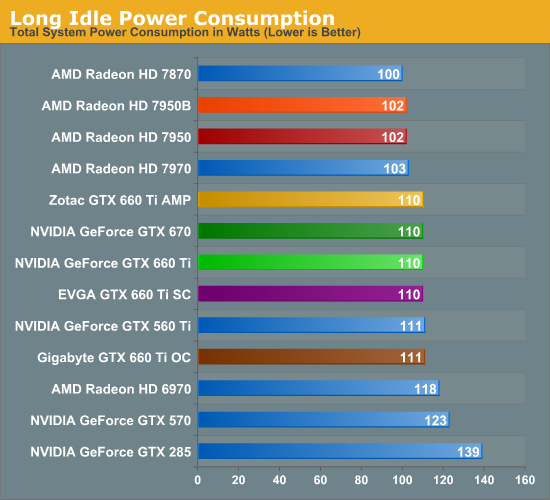
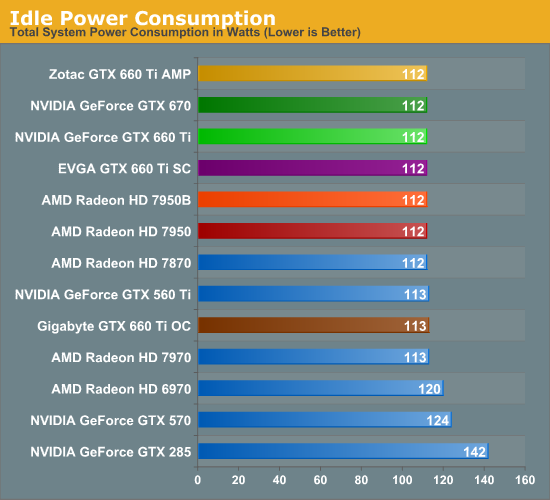
There are no great surprises with idle power consumption. Given the immense similarity between the GTX 670 and GTX 660 Ti, they end up drawing the same amount of power both during idle and long idle. This does leave AMD with an 8W-10W lead at the wall in this test though.
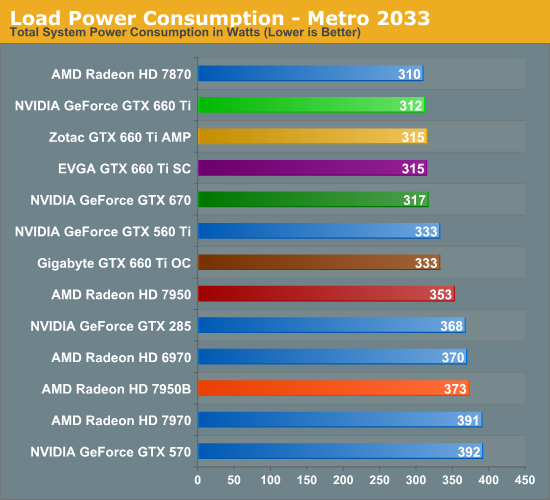
Moving on to our load power tests we start with Metro: 2033. As we mentioned previously the GTX 660 Ti and GTX 670 have very similar power targets, and this benchmark confirms that. Power consumption for the GTX 660 Ti is virtually identical to the Radeon HD 7870, an interesting matchup given the fact that this is the first time NVIDIA has had to compete with Pitcairn. Pitcairn’s weaker compute performance means it starts off in a better position, but it looks like even with a salvaged GK104 NVIDIA can still compete with it. NVIDIA drove efficiency hard this generation; to compete with a smaller chip like that is certainly a testament to that efficiency.
As for the inevitable 7950 comparison, it’s no contest. The GTX 670 was already doing well here and the GTX 660 Ti doesn’t change that. Tahiti just can’t match GK104’s gaming efficiency, which is why AMD has had to push performance over power with the new 7950B.
Meanwhile it’s fascinating to see that the GTX 660 Ti has lower power consumption than the GTX 560 Ti, even though the latter has the advantage of lower CPU power consumption due to its much lower performance in Metro. Or better yet, just compare the GTX 660 Ti to the outgoing GTX 570.
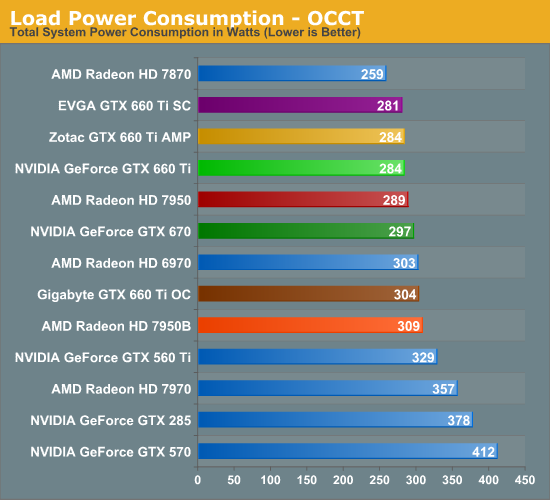
For AMD/NVIDIA comparisons we have a bit less faith in our OCCT results than we do our Metro results right now, as NVIDIA and AMD seem to clamp their power consumption differently. NVIDIA’s power consumption clamp through GPU Boost is far softer than AMD’s PowerTune. As a result the 7870 consumes 25W less than the GTX 660 Ti here, which even with AMD’s very conservative PowerTune rating seems like quite the gap. Metro seems to be much more applicable here, at least when you’re dealing with cards that have similar framerates.
In any case, compared to NVIDIA’s lineup this is another good showing for the GTX 660 Ti. Power consumption at the wall is 45W below the GTX 560 Ti, a large difference thanks to the latter’s lack of power throttling technology.
As for our factory overclocked cards, these results are consistent with our expectations. Among the Zotac and EVGA cards there’s a few watts of flutter at best, seeing as how they have the same power target of 134W. Meanwhile the Sapphire card with its higher power target is 20W greater at the wall, which indicates that our estimated power target of 141W for that card is a bit too low. However this also means that those times where the Gigabyte card was winning, it was also drawing around 20W more than its competition, which is a tradeoff in and of itself.
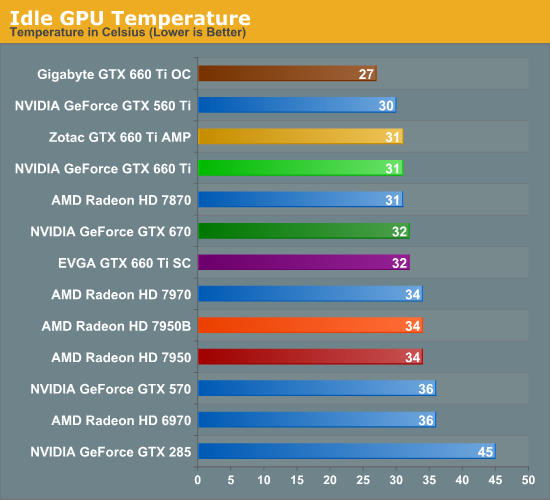
Moving on to temperatures, at 31C the GTX 660 Ti is once more where we’d expect it to be given the similarities to the GTX 670. Open air coolers tend to do a bit better here than blowers though, so the fact that it’s only 1C cooler than the blower-type GTX 670 is likely a reflection on Zotac’s cooler.
Speaking of factory overclocked video cards, one card stands out above the rest: the Gigabyte GTX 660 Ti. That oversized cooler does its job and does it well, keeping the GPU down to barely above room temperature.
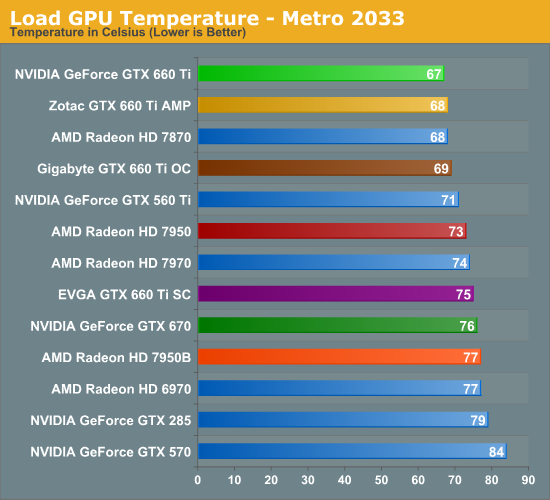
Considering that most of our high-end cards are blowers while our “reference” GTX 660 Ti is an open air cooler, temperature benchmarks are the GTX 660 Ti’s to win, and that’s precisely what’s going on. 67C is nice and cool too, which means that the open air coolers should fare well even in poorly ventilated cases.
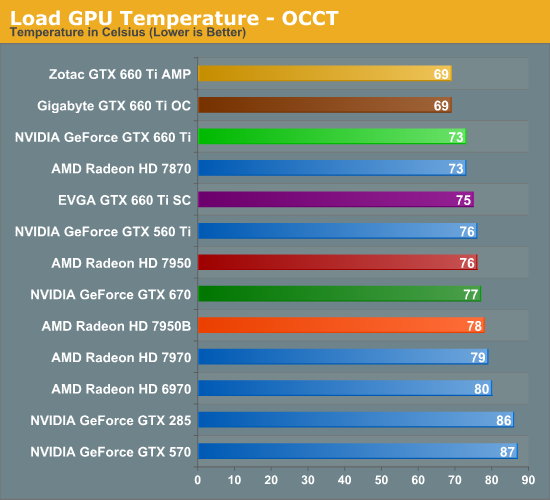
As usual we see a rise in temperatures when switching from Metro to OCCT, but at 73C the GTX 660 Ti is still the coolest reference (or semi-reference) card on the board. To be honest we had expected that it would beat the 7870, but as far as blowers go the 7870’s is quite good.
Moving on to our factory overclocked cards, we’re seeing the usual divisions between open air coolers and blowers. The blower-based EVGA card performs almost identically to the GTX 670, which makes sense given the similarities between the cards. Meanwhile the open air Zotac and Gigabyte cards are neck-and-neck here, indicating that both cards are shooting for roughly the same temperatures, keeping themselves below 70C. Though it’s somewhat weird to see the factory overclocked Zotac card end up being cooler than its reference-clocked self; this appears to be a product of where the fan curve is being hit.
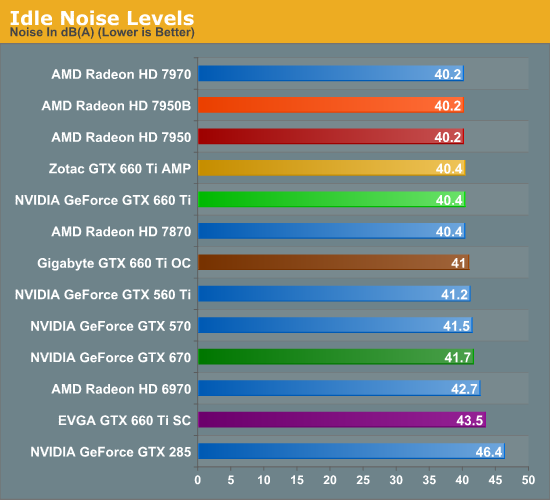
Last but not least we have our look at noise, where we’ll hopefully be able to fully shake out our factory overclocked cards.
Right off the bat we see the blower-based EVGA struggle, which was unexpected. It’s basically the same cooler as the GTX 670, so it should do better. Then again the EVGA GTX 670 SC had the same exact problem.
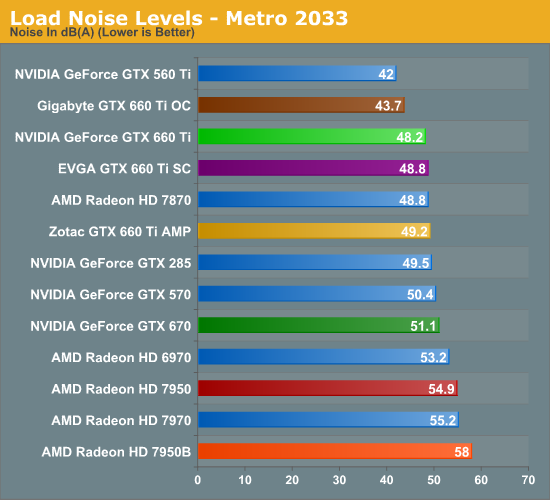
As for Metro, the GTX 660 Ti once again looks good. 48.2 isn’t the best for an open air cooler, but it’s a hair quieter than the 7870 and notably quieter than the GTX 670. The only unfortunate part about these results is that it just can’t beat the GTX 560 Ti; in fact nothing can. For its power consumption the GTX 560 Ti was an almost unreal card, but it’s still a shame the GTX 660 Ti can’t be equally unreal.
Moving on to our factory overclocked cards however, the Gigabyte GTX 660 Ti OC gets very close thanks to its very large cooler. 43.7dB technically isn’t silent, but it just as well should be. To offer the performance of a GTX 660 Ti (and then some) in such a package is quite the accomplishment.
As for Zotac and EVGA, there’s nothing bad about either of them but there’s also nothing great. EVGA’s card is about average for a blower, while Zotac’s card seems to be suffering from its size. It’s a relatively tiny card with a relatively tiny cooler, and this has it working harder to hit its temperature targets.
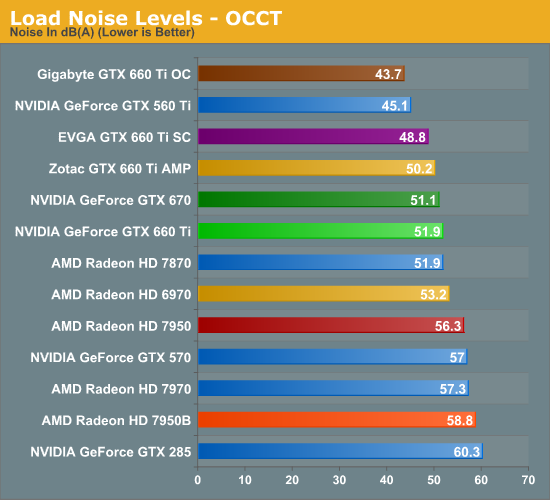
Finally we have noise testing with OCCT. Our “reference” GTX 660 Ti actually fares a bit worse than the GTX 670, which is unfortunate. So much of this test comes down to the cooler though that it’s almost impossible to predict how other cards will perform. At least it’s no worse than the 7870.
Meanwhile the Gigabyte GTX 660 Ti OC continues to impress. 43.7dB not only means that it didn’t get any louder switching from Metro to OCCT, but it has now bested the GTX 560 Ti thanks to the 560’s lack of power throttling technology. Make no mistake, 43.7dB for this kind of performance is very, very impressive.
As for EVGA and Zotac, it’s also a rehash of Metro. EVGA’s blower is actually over 1dB quieter than Zotac’s cooler, which is an unfortunate outcome for an open air cooler.
Wrapping things up, even without a true reference sample from NVIDIA it’s clear that the GTX 660 Ti has a lot of potential when it comes to power/temp/noise. Compared to other cards it’s roughly equivalent in power consumption and noise to the 7870, which for NVIDIA is an important distinction since it’s also notably faster than the 7870, so NVIDIA is on a better place on the power/performance curve. This goes for not only the 7870, but especially the 7950, where the GTX 660 Ti continues the tradition the GTX 670 already set, which will see the GTX 660 Ti being cooler, quieter, and less power hungry than AMD’s entry-level Tahiti part.
But it must be pointed out that the lack of a reference design for the GTX 660 Ti means buyers are also facing a lot of variability. Power consumption should be consistent between cards – which is to say a hair less than the GTX 670 – but temperature and especially noise will vary on a card by card basis. Potential buyers would best be served by checking out reviews ahead of time to separate the duds from the gems.










313 Comments
View All Comments
TheJian - Friday, August 24, 2012 - link
Pity I hadn't dug a bit further and found this also...I just checked 3 sites and used them...LOL.Even crysis 2 is a wash ~1fps difference 1920x1080 and above again we see below 30min fps even on 7950B. It takes the 7970 to do 30 and it won't be there all day. It will likely dip under 30. Ryan comments a few times your experience won't be great below 60 as those will dip :)
The 7950 or B rises with volts and a lot of them have a hard time hitting over 1150 and run 80watts more. Not good if that's how you have to clock your card to keep up (or even win...it's bad either way). The one at guru3d.com was a regular 7950 that those #'s came from so it will have a hard time beating a 1300mhz much on NV's side. Memory can hit 7.71 as shown at hardocp with ONE sample. Must be pretty easy. Memory won't be an issue at 1920x1200 or even less at 1920x1080 and you can OC the mem any time you like :) Interesting article.
Again, 1322/6.7ghz on mem. Above Zotac Amp in both cases. Easy to hit 1300 I guess ;) and it still won't be as hot/noisy or use as many watts at those levels. Not that I'd run either card at max. They're all great cards, it's a consumers dream right now, but NV just seems to be in better position and Ryan's comments were just out of touch with reality.
CeriseCogburn - Saturday, August 25, 2012 - link
Well as far as the overclocking that's almost all amd people were left with since the 600 series nVidia released.All the old whines were gone - except a sort of memory whine. That gets proven absolutely worthless, but it never ends anyway.
Amd does not support their cards with drivers properly like nvida, that's just a fact they cannot get away from, no matter how many people claim it's a thing of the past it comes up every single launch, and then continues - that INCLUDES this current / latest amd card released.
So... it's not a thing of the past.
No matter how many amd liars say so, they're lying.
CeriseCogburn - Saturday, August 25, 2012 - link
I saw this when their article hit but here is a good laugh... after the you know who fans found it so much fun to attack nVidia about " rejected chips" that couldn't make the cut, look what those criticizers got from their mad amd masters !" These numbers paint an interesting picture, albeit not one that is particularly rosy. For the 7970 AMD was already working with top bin Tahiti GPUs, so to make a 7970GE they just needed to apply a bit more voltage and call it a day. The 7950 on the other hand is largely composed of salvaged GPUs that failed to meet 7970 specifications. GPUs that failed due to damaged units aren’t such a big problem here, but GPUs that failed to meet clockspeed targets are another matter. As a result of the fact that AMD is working with salvaged GPUs, AMD has to apply a lot more voltage to a 7950 to guarantee that those poorly clocking GPUs will correctly hit the 925MHz boost clock. "
ha
ROFLMHO - oh that great, great, great 40% overclocker needs LOTS OF EXTRA VOLTAGE - TO HIT 925 mhz ..
LOL
http://www.anandtech.com/show/6152/amd-announces-n...
Oh man you can't even make this stuff up !
HAHAHAHAHHAHAHAHAHAAAAAaaaa
Ambilogy - Saturday, August 25, 2012 - link
Oh you were comparing it to the 7950? I was promoting the 7870 :) in the spanish forums they did they own kind of review because they don't trust this kind of page reviews and the OC 7870 of a member performs better than the OC 660TI.So if we talk about the 7950
The winner is clear, the 7950 wins, you are all facts well deal with this:
Techpowerup did the most quantity of games, also reviewed the 660TI in 4 diferent reviews for each edition, you can talk all you want nvidia fanboys but techpowerup showed that for your 1080p, 7950 is 5% slower than 660TI, but then w1zzard himself has a post in the forum that you have to suppose a 5% increase in performance for 7950 for the boost he did not include. Which yields equal performance at average, not only that but tom's hardware shows something you have forgotten, minimum FPS rendered in the games, which shows 660TI horrible minimum FPS that indicate a very unstable card, my guess is your god card has very high highs for the good GPU core but when things get demanding the memory bandwidth can't keep the pace, inducing some kind of lag segments.
It's easy, if they render the same performance average in games with almost the same price, the card that wins is the one with the better features: That is GPGPU, frame stability and overclock, which is by far much more important than closed source Physx for 2 games every hundred years. Why? OpenCL is starting to get used more and more, and it's showing awesome results. Why does nvidia cards sell more? well they still tell the reviewers how to review the card to make it look nice, they made a huge hype of their products and they have a huge fanbase that cannot see:
1- Nvidia is selling chips which only look good today so they have faster obsolescence and therefore they can sell their next series better.
2- They are completely oblivious to the fact that they see amd cards with a non objective point of view.
3- Proofs of equally performing amd cards with more OC rom is ussuallly defended by them talking about the past and attacking the so called amd fanboys as follows:
"REALLY IS CRAPPY CHIPS from the low end loser harvest they had to OVER VOLT to get to their boost...
LOL
LOL\
OLO
I mean there it is man - the same JUNK amd fanboys always use to attack nVida talking about rejected chips for lower clocked down the line variants has NOW COME TRUE IN FULL BLOWN REALITY FOR AMD....~!
HAHHAHAHAHAHAHAHHAHA
AHHAHAHAHAHAA
omg !
hahahahahahhahaha
ahhahaha
ahaha
Holy moly. hahahahahhahahha"
Telling chips are bad without using them, manipulating info showing reviews that favor nvidia, exaggerating features that are not so important, ignoring some that are.
Explain to me how what I quoted (in example) changes the fact that I can go and buy a 7950 with pre OC and have same performance in average due to w1zz studies, and even OC more and forget about 660TI. Explain to me, how that overly exaggerated laugh changes the minimum frame rates of the TI and makes it good for no reason. Well It doesn't change anything actually.
The only cure I see for you fan-guys is get a 7950 and OC it, or buy a good version already, then you would stop complaining the moment you see its not a bad card. And also get the 660TI so you can compare also. You will see no difference that could make you still think AMD cards are crap, you will not see the driver issues, you will notice that physx don't make the difference, and hopefully you will be a more balanced person.
I'm not a fanboy, I like nvidia cards, I have had a couple, and to me the 670 is a great card, but not this 660TI crap, I'm not a fanboy because I know to see when a company makes a meh release.
CeriseCogburn - Sunday, August 26, 2012 - link
I've already had better, so you assume far too much, and of course, are a fool. YOU need to go get the card and see the driver problems, PERSONALLY, instead of talking about two other people on some forum...Get some personal experience.
NEXT: Check out the Civ 5 COMPUTE Perf above - this site has the 6970 going up 6+fps while the GTX570 goes down 30 fps... from the former bench...
http://www.anandtech.com/show/4061/amds-radeon-hd-...
LOLOL
No bias here.....
The 580 that was left out of this review for COMPUTE scored EQUIVALENT to the 7970, 265.7 fps December of 2010.
So you want to explain how the 570 goes down, the 580 is left out, and the amd card rises ?
Yeah, see.... there ya go and famboy - enjoy the cheatie lies.
Cliffro - Saturday, September 1, 2012 - link
The comment section is filled with delusional fanboys from both camps.To the Nvidia fanboys, the 600 series is great when you get a working card, that doesn't just randomly start losing performance and then eventually refuse to work at all. Doesn't Red Screen of Death. or get constant "Driver Stopped Responding" errors etc etc. No review mentions these issues.
To the AMD Fanboys, the drivers really do suck, the grey screen of death issue is/was a pain, card not responding after turning off the monitors after being idle for however long also sounds like a PITA. Again no review has ever mention these issues.
I've been using Nvidia the majority of my time gaming, and have used ATI/AMD as well though. Neither one is perfect, both have moments where they just plain SUCK ASS!
I'm currently using 2 GTX 560 Ti's and am currently considering up/sidegrading to a single 670/680 or 7970/7950, and during my research I've read horror stories about both the 600 series and the 7000 series. What's funny is everyone ALWAYS says look at the reviews, none of which mention the failures from both camps. none speak of reliability of the cards, because they have them and test them in what a week's time period at most?
Here's a good example, one of the fastest 670's was the Asus 670 DCII Top, it got rave reviews, but got horrible user reviews because of reliability issues, got discontinued, and is no longer available at Newegg.
I can see why EVGA dropped their lifetime warranty.
All of this said, I'm actually leaning towards AMD this round, sure they have issues and even outright failures but they aren't as prominent as the ones I'm reading about from Nvidia. I don't like feeling like I'm playing the lottery when buying a video card, and with the 600 series from Nvidia that's the feeling I'm getting.
Cliffro - Saturday, September 1, 2012 - link
I forgot to say YMMV at the end there.CeriseCogburn - Monday, September 3, 2012 - link
Right at the newegg 680 card you cherry picked for problems.."Cons: More expensive than the other 670's
Other Thoughts: This card at stock settings will beat a stock GTX680 at stock settings in most games. I think this is the best deal for a video card at the moment.
I sold my 7970 and bought this as AMD's drivers are so bad right now. Anytime your computer sleeps it will crash, and I was experiencing blue screens in some games. I switched from 6970's in crossfire to the 7970 and wished I had my 6970's back because of the driver issues. This card however has been perfect so far and runs much much cooler than my 6970's! They would heat my office up 20 degrees!
I also have a 7770 in my HTPC and am experiencing driver issues with it as well. AMD really needs to get there act together with their driver releases! "
LOL - and I'm sure there isn't an amd model design that has been broken for a lot of purchasers....
Sure....
One card, and "others here are rabid fanboys" - well if so, you're a rabid idiot.
mrfunk10 - Thursday, September 6, 2012 - link
lol you've gotta be one of the most ridiculous, blind, hard-headed fanboy troll noobs i've ever seen on the internet. The amd 7 series atm are great cards and at $300 for the 7950 i'm sure they make nvidia sweat. I myself am running a gigabyte windforce 660ti an am very happy with it but mygod can the 79's oc.Cliffro - Saturday, September 8, 2012 - link
"One card, and "others here are rabid fanboys" - well if so, you're a rabid idiot. "Have you not noticed your own constant posting of Pro Nvidia statements, and at the same time bashing AMD? And I said delusional not rabid. Though you may be on to something with that.....
EVGA recalled a lot of 670 SC's, gave out FTW models(680 PCB) as replacements. Something about a "bad batch".
Maybe it's an partner problem, maybe it's an Nvidia problem I don't know. But I know Asus DCII cards have lots of low ratings regardless if it's AMD or Nvidia. The Asus 79xx cards with DCII have 3 eggs or less overall, similar to the 6xx series from them. Gigabyte has better ratings, and less negatives than Asus, MSI and even EVGA on some models. So maybe it is a partner problem.
I also must be imagining my Nvidia TDR errors or drivers/cards crashing (with no recovery) while playing a simple game (Bejeweled 3, yeah I know...) and other games occasionally as well since Nvidia can do nothing wrong in the driver department right? Just like my AMD friend seemed to think I was imagining my AMD driver issues when I had my HD 2900 Pro.
It's also funny that I'm being attacked by a "Devoted Nvidia fan", and my friends usually consider me a "Devoted Nvidia fan". Go figure. I've never been totally against any company, never anti-Intel or AMD, or Nvidia or ATI/AMD. The only company I have avoided is Hitatchi and their hard drives, and Intel initially because honestly their stuff seemed overpriced during the P4 days.
Maybe I'm just getting cynical as I get older...but Hard Drives started becoming unreliable the last couple of years, and now video cards are suffering more failures than I'm used to seeing. And SSD's with Sandforce seem to suck ass as well reliability wise, they are almost comparable with the 600 series, high speed and more failures than I'm comfortable with. Though in Nvidia's defense even the 600 series isn't as bad as Sandforce or OCZ or Seagate.